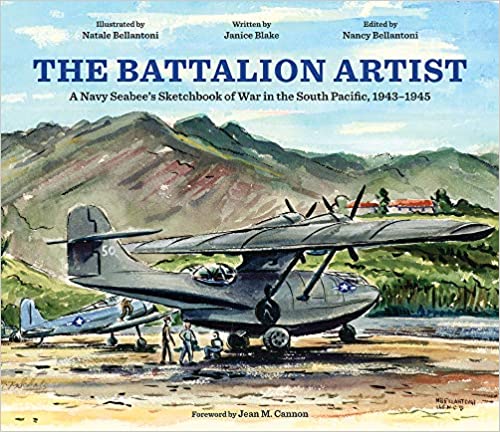
Reviewed by CAPT Charles “Herb” Gilliland, USN (Ret.)
For any artist—perhaps for any human being–life and art are inseparable. That was certainly the case for Natale (“Nat”) Bellantoni. This strikingly attractive book filled with fine watercolors offers his story as a young artist serving in the 78th Naval Construction Battalion in World War II. Two years into his training at the Massachusetts School of Art and not quite a year after Pearl Harbor, and motivated like so many by a combination of patriotism and the draft, Nat Bellantoni enlisted in the “Seabees.” His boxes of sketchbooks, papers, and photos having been recently donated by his family to The Hoover Institution, the time was ripe for publication.
Nat Bellantoni himself, as edited by his daughter Nancy Bellantoni, shows the story, in watercolor paintings and sketches, and bits of ephemera he saved along the way, plus photographs presumably taken by the battalion photographer, Ed Keegan. The new carpenter’s mate was soon put to work painting camouflage, making signs and labels, and creating colorful nose art on various aircraft. He was on the staff of the battalion newspaper. At some point he became recognized as the battalion artist. Whether on his own time or not, Nat sketched and painted wherever he went: Noumea, New Guinea, the Admiralty Islands, New Caledonia. By the time Nat enlisted, the U.S. Navy’s Combat Art unit had recruited and deployed around the world a select few well-established artists to make an official artistic record of the war. Nat, having interrupted his art training to enlist as a carpenter’s mate, would not have been among them. His watercolors, however, would not look out of place beside theirs. Such details as the strong brush strokes of thatching on the church on Ponam Island and the smooth shadowing in blues and grey of a ship’s antiaircraft station indicate great skill.
Janice Blake tells the story by putting the reader in Nat Bellantoni’s mind as she takes him from art school in Boston to joining the Seabees and then across the Pacific from island to island, and eventually, and happily, back home. Blake’s lightly fictionalized method adds immediacy and a sense of movement to the reading experience. Presumably based upon the copious letters, diaries and other materials Bellantoni kept in addition to his sketches and painting, the narrative carries us seamlessly along through the paintings and photographs and Nat’s thoughts. We are willing to accept such plausible interpolations as, “‘Maybe it won’t be so bad,’ Nat thought as he shouldered his seabag.” At one point, oddly, Nat seems to remember Admiral Rickover and his now-famous Breton prayer, though Rickover in 1944 was an unknown lieutenant commander. In contrast, the sad story of PBY-50, fully known only decades after the war, is deftly handled. As the title indicates, though, the purpose of the book is to showcase the art, and in this it succeeds impressively. Blake “reads” many of the paintings as Nat might have, in terms of their subjects and contexts. For example, a bombed stone bridge “look[s] out of place against the riotous colors of nature: green and gold grasses on the hillside, the trees that stood blue in the morning light.” Elsewhere, we are reminded that a formation of tiny aircraft in the sky of a landscape of cliffs and lush plants are on their way to bomb Japan.
The wide (9 ½” x 11”) format gives appropriately full scope to many of the watercolors. At the same time the generous use of “white space” gives the reader an experience akin to being in a gallery, moving from painting to painting while reading the labels on the wall, or perhaps while listening to the voice of someone who knew him well. Of course, Nat Bellantoni’s story here is also the story of Construction Battalion 78, and in a larger sense the story of Seabees in the Pacific war. At the same time, this book adds an entirely new chapter to the artistic record of the U.S. Navy in World War II. It will engage anyone interested in that story, or in the Seabees.
Janice Blake, The Battalion Artist: A Navy Seabee’s Sketchbook of War in the South Pacific. Ill. Natale Bellantoni, ed. Nancy Bellantoni. Hoover Institution Press, Stanford, CA. 2019. 124 pp. Illus. Hb $39.95.
Reviewed by CAPT C. “Herb” Gilliland, USN (Ret.), frequent NHF book reviweer.
Purchase your copy of Battalion Artist today! amzn.to/2Zbzhq2


edwardmorgan392@gmail.com